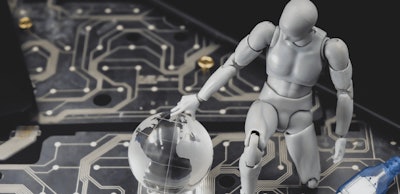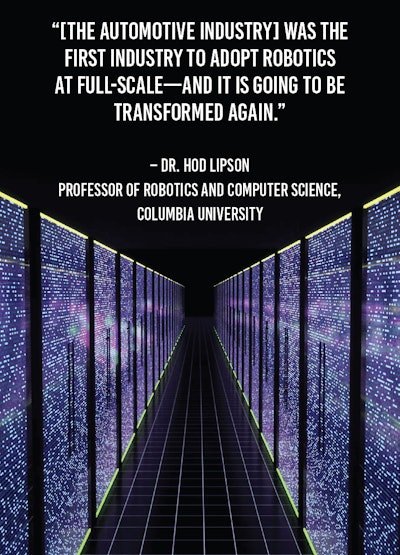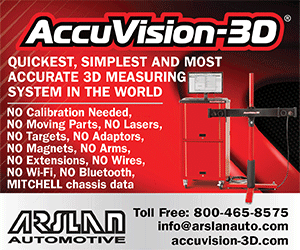
Meet your new colleague – artificial intelligence
By MAX REID
Cutting-edge artificial intelligence technology has very quickly found a place in nearly every corner of the modern collision repair facility.
For nearly every new tool or piece of software you purchase, somewhere in the instructions is likely a phrase that reads “powered by Artificial Intelligence,” “driven by machine-learning,” or something along those lines.
It sounds impressive, but how many of those currently working in the collision repair field understand what these terms mean? The average repair tech, or manager for that matter, could be forgiven for not fully grasping how the 15-year-old computer on their desk is not an artificial intelligence, but the colour-matching app on their phone is. While the nitty gritty details of how this technology works have not traditionally been within the purview of a hammer-wielding body technician, it has become crucial that the aftermarket repair industry get informed, or risk losing a seat at the table when wider vehicle data decisions are made.
Professor of robotics and computer science at Columbia University, Dr. Hod Lipson, said it well at Fix Network’s Fall Conference in September 2022, pointing out to a room of aftermarket executives that “the automotive industry has been changed by robotics in the past—it was the first industry to adopt robotics at full-scale—and it is going to be transformed again.”
To put it very simply, machine-learning is the process by which an AI is “taught” how to operate, and within what parameters, as determined by an algorithm. Different algorithms make use of different methods to compile data.
For example, a decision-tree model gains information about a piece of data by having it pass through a series of gates, or forks in the decision tree, that answer a certain question about the data, narrowing the possible results as it goes.
Other common algorithms include basic rules-based “if/then” models, where an AI makes binary decisions based on individual criterion being met; and cluster algorithms, where data with similar characteristics are grouped together and the AI decides on the most suitable result, often on a majority basis. From here, it can be easier to see how these algorithms present themselves within a vehicle. For example, a vehicular camera system may use an “if/then” rule system to make decisions that affect whether a safety system activates. “If the object passing the camera is a leaf, then ignore.” Versus, “if the object passing in front of the camera is a pedestrian, then engage automatic brakes.”
According to Lipson, this advancement in the ability of AI to actually recognize the objects they see is actually quite recent. “They could detect objects and avoid them, but we don’t just detect objects. We understand what us and how other cars is around are likely to behave,” he said “For the first time, cars can finally understand what is around them.”
Think of machine-learning like a government and the algorithms as the building in which it operates. If you want a democracy, you need a parliament, and parliaments have an understood process by which they function (i.e., debates, voting, representation). Every form of government has its possibilities and its limitations, and it is important that the collision repair industry get a grasp on what serves them best. A spokesperson for Blackberry’s automotive data platform, IVY, in conversation with Collision Repair, said they consider the ideal of AI for drivers as for it to function as a “digital butler” within the vehicle. Modern driver-facing, AI-powered ADAS helps operate features like adaptive cruise control, automatic emergency braking, hands-free driving, as well as predictive traffic reporting.

To put it very simply, machine-learning is the process by which an AI is “taught” how to operate, and within what parameters, as determined by an algorithm. Different algorithms make use of different methods to compile data.
Essentially, the level of machine intelligence we currently sit at today— approximately 95 percent as powerful as a human brain—must learn and make mistakes the same way that an up-andcoming human estimator might.

Extending beyond the individual driver and into the aftermarket, they said that Blackberry’s AI is capable of forecasting maintenance repairs for entire fleets of vehicles, and thereby offering fleet managers a leg-up in efficiency, even down to the local level.
“Some markets may require more brake changes; some markets need less. Some people do more city driving; some people do more highway driving,” they said. “Across the vehicle, these maintenance and repair elements can actually be more targeted and focused, versus based on a rudimentary estimation.”
When put toward our readers, a common thread echoed throughout a recent Collision Repair survey voiced concern over the idea that an AI can effectively estimate repairs, with many respondents claiming that given the many tiny exceptions and nuances involved in modern collision repair, no intelligence could fully replace the learned eye of a human estimator. While true to an extent, the issue with that line of thinking, however, is that by the nature of a machine-learning intelligence, it must be continually taught and fed new data so that it may expand its knowledgebase and carry out correct estimates faster and more often. Essentially, the level of machine intelligence we currently sit at today—approximately 95 percent as powerful as a human brain, according to Lipson—must learn and make mistakes the same way that an up-and-coming human estimator might.
The difference lies in the fact that the AI will get a handle on the job far faster and with greater efficiency than one of those flesh-covered desk jockeys. After a while, the AI requires little more than a handler to keep an eye out for potential outlier data.
With these variables in mind, shop owners must decide for themselves where in their shop an AI-powered system would serve them best, as there is no magic computer program that will make your shop run on autopilot, nor is it realistic to attempt to opt out of AI altogether.
Part of the impetus behind software like Blackberry’s IVY is to provide more avenues for the monetization of your vehicle data for the profit of OEMs—the company is forthright about that on their website.
As readers of our last issue will recall, the fight for vehicle data rights for repairers is a hard-fought battle and automakers are not making it any easier for our industry’s technicians to access the information they need.
Middleware developers like Blackberry and their IVY platform are actively making it easier for OEMs to funnel vehicle data back in-house for the express purpose of monetization.
This is why it is imperative that whether it be the vehicles you work on, or the tools you equip your shop with, if you see that “powered by Artificial Intelligence” sticker somewhere on it–do some research, follow the money and stay knowledgeable as the right to repair movement grows ever more complex.























